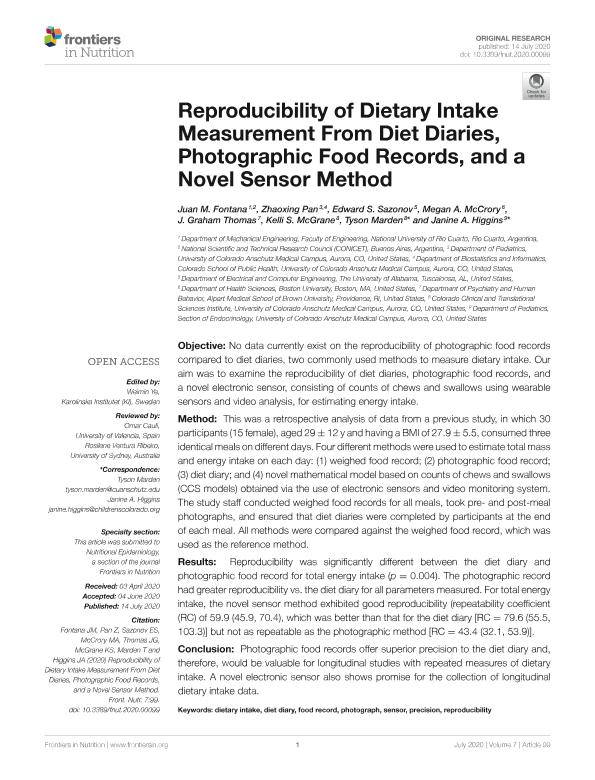Artículo
Reproducibility of Dietary Intake Measurement From Diet Diaries, Photographic Food Records, and a Novel Sensor Method
Fontana, Juan Manuel ; Pan, Zhaoxing; Sazonov, Edward S.; McCrory, Megan A.; Thomas, J. Graham; McGrane, Kelli S.; Marden, Tyson; Higgins, Janine A.
; Pan, Zhaoxing; Sazonov, Edward S.; McCrory, Megan A.; Thomas, J. Graham; McGrane, Kelli S.; Marden, Tyson; Higgins, Janine A.
 ; Pan, Zhaoxing; Sazonov, Edward S.; McCrory, Megan A.; Thomas, J. Graham; McGrane, Kelli S.; Marden, Tyson; Higgins, Janine A.
; Pan, Zhaoxing; Sazonov, Edward S.; McCrory, Megan A.; Thomas, J. Graham; McGrane, Kelli S.; Marden, Tyson; Higgins, Janine A.
Fecha de publicación:
07/2020
Editorial:
Frontiers Media
Revista:
Frontiers in Nutrition
ISSN:
2296-861X
Idioma:
Inglés
Tipo de recurso:
Artículo publicado
Clasificación temática:
Resumen
Objective: No data currently exist on the reproducibility of photographic food records compared to diet diaries, two commonly used methods to measure dietary intake. Our aim was to examine the reproducibility of diet diaries, photographic food records, and a novel electronic sensor, consisting of counts of chews and swallows using wearable sensors and video analysis, for estimating energy intake. Method: This was a retrospective analysis of data from a previous study, in which 30 participants (15 female), aged 29 ± 12 y and having a BMI of 27.9 ± 5.5, consumed three identical meals on different days. Four different methods were used to estimate total mass and energy intake on each day: (1) weighed food record; (2) photographic food record; (3) diet diary; and (4) novel mathematical model based on counts of chews and swallows (CCS models) obtained via the use of electronic sensors and video monitoring system. The study staff conducted weighed food records for all meals, took pre- and post-meal photographs, and ensured that diet diaries were completed by participants at the end of each meal. All methods were compared against the weighed food record, which was used as the reference method. Results: Reproducibility was significantly different between the diet diary and photographic food record for total energy intake (p = 0.004). The photographic record had greater reproducibility vs. the diet diary for all parameters measured. For total energy intake, the novel sensor method exhibited good reproducibility (repeatability coefficient (RC) of 59.9 (45.9, 70.4), which was better than that for the diet diary [RC = 79.6 (55.5, 103.3)] but not as repeatable as the photographic method [RC = 43.4 (32.1, 53.9)]. Conclusion: Photographic food records offer superior precision to the diet diary and, therefore, would be valuable for longitudinal studies with repeated measures of dietary intake. A novel electronic sensor also shows promise for the collection of longitudinal dietary intake data.
Palabras clave:
DIET DIARY
,
DIETARY INTAKE
,
FOOD RECORD
,
PHOTOGRAPH
,
PRECISION
,
REPRODUCIBILITY
,
SENSOR
Archivos asociados
Licencia
Identificadores
Colecciones
Articulos (IDAS)
Articulos de INSTITUTO PARA EL DESARROLLO AGROINDUSTRIAL Y DE LA SALUD
Articulos de INSTITUTO PARA EL DESARROLLO AGROINDUSTRIAL Y DE LA SALUD
Citación
Fontana, Juan Manuel; Pan, Zhaoxing; Sazonov, Edward S.; McCrory, Megan A.; Thomas, J. Graham; et al.; Reproducibility of Dietary Intake Measurement From Diet Diaries, Photographic Food Records, and a Novel Sensor Method; Frontiers Media; Frontiers in Nutrition; 7; 7-2020; 1-6
Compartir
Altmétricas



